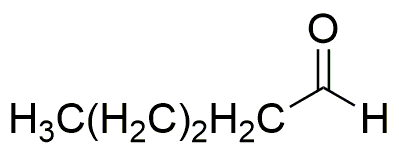Valeraldehyde is widely utilized in research focused on:
- Flavoring and Fragrance Industry: It is commonly used as a flavoring agent in food products and as a fragrance component in perfumes, providing a pleasant, nutty aroma.
- Synthesis of Chemicals: Valeraldehyde serves as an important intermediate in the synthesis of various chemicals, including pharmaceuticals and agrochemicals, enhancing the efficiency of production processes.
- Polymer Production: This compound is utilized in the manufacture of certain polymers, contributing to materials with desirable properties, such as flexibility and durability.
- Analytical Chemistry: It is used in analytical methods for detecting and quantifying specific compounds, aiding researchers in quality control and product development.
- Biochemical Research: Valeraldehyde is employed in studies related to metabolic pathways, helping scientists understand its role in biological systems and potential therapeutic applications.
General Information
Properties
Safety and Regulations
Applications
Valeraldehyde is widely utilized in research focused on:
- Flavoring and Fragrance Industry: It is commonly used as a flavoring agent in food products and as a fragrance component in perfumes, providing a pleasant, nutty aroma.
- Synthesis of Chemicals: Valeraldehyde serves as an important intermediate in the synthesis of various chemicals, including pharmaceuticals and agrochemicals, enhancing the efficiency of production processes.
- Polymer Production: This compound is utilized in the manufacture of certain polymers, contributing to materials with desirable properties, such as flexibility and durability.
- Analytical Chemistry: It is used in analytical methods for detecting and quantifying specific compounds, aiding researchers in quality control and product development.
- Biochemical Research: Valeraldehyde is employed in studies related to metabolic pathways, helping scientists understand its role in biological systems and potential therapeutic applications.
Documents
Safety Data Sheets (SDS)
The SDS provides comprehensive safety information on handling, storage, and disposal of the product.
Product Specification (PS)
The PS provides a comprehensive breakdown of the product’s properties, including chemical composition, physical state, purity, and storage requirements. It also details acceptable quality ranges and the product's intended applications.
Certificates of Analysis (COA)
Search for Certificates of Analysis (COA) by entering the products Lot Number. Lot and Batch Numbers can be found on a product’s label following the words ‘Lot’ or ‘Batch’.
*Catalog Number
*Lot Number
Certificates Of Origin (COO)
This COO confirms the country where the product was manufactured, and also details the materials and components used in it and whether it is derived from natural, synthetic, or other specific sources. This certificate may be required for customs, trade, and regulatory compliance.
*Catalog Number
*Lot Number
Safety Data Sheets (SDS)
The SDS provides comprehensive safety information on handling, storage, and disposal of the product.
DownloadProduct Specification (PS)
The PS provides a comprehensive breakdown of the product’s properties, including chemical composition, physical state, purity, and storage requirements. It also details acceptable quality ranges and the product's intended applications.
DownloadCertificates of Analysis (COA)
Search for Certificates of Analysis (COA) by entering the products Lot Number. Lot and Batch Numbers can be found on a product’s label following the words ‘Lot’ or ‘Batch’.
*Catalog Number
*Lot Number
Certificates Of Origin (COO)
This COO confirms the country where the product was manufactured, and also details the materials and components used in it and whether it is derived from natural, synthetic, or other specific sources. This certificate may be required for customs, trade, and regulatory compliance.

